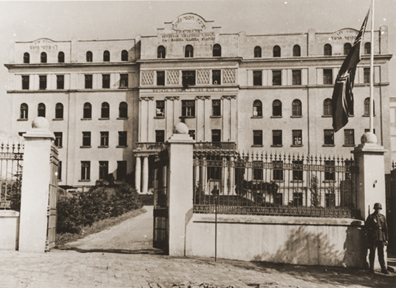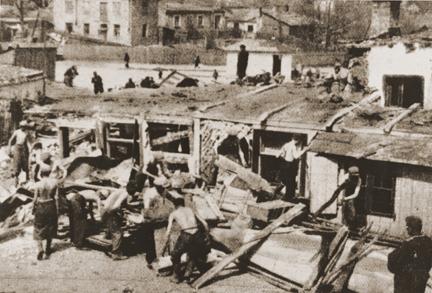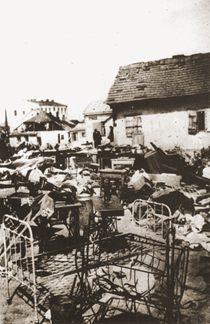My Visit to Lublin, Poland
My visit in October 1998 to the city
of Lublin in eastern Poland began with a drive southeast from
Warsaw through a great swath of farmland that stretches as far
as the eye can see and is as flat as Kansas or the San Joaquin
Valley in California. There are many long stretches of the road
which go through a double line of trees, many of them dying from
the mistletoe that clings to their branches.
There are roadside stands selling food
and drivers just pull off the road; this is not a freeway and
there are no exit ramps. Prostitutes wearing provocative clothing
line both sides of the road to accommodate truck drivers traveling
in either direction. Standing right alongside them are peasant
women making a few extra zlotys by selling the wild mushrooms
they have picked in the forest.
The major farm crop in this area seems
to be potatoes, although the land is broken up into many small
fields without fences, rather than large fields planted in a
single crop. Lublin is in southeastern Poland where the land
was formerly divided into great feudal estates, owned by a few
aristocratic families, while the majority of the people were
serfs or peasants. Farming in this area is still done manually
by peasants or with horse drawn farm implements, although you
also see a few tractors out in the fields or traveling on the
highway with the cars.
Southeastern Poland is still sparsely
populated and there is a lot of forest land remaining. It is
easy to see why the Germans coveted this great wealth of land
for their "Lebensraum," and thought of this area as
comparable to the American West. One gets the impression that
this is land that is not being used for maximum food production.
This part of Poland is a great plain which continues on into
the Ukraine to the east.
With so many forests for partisans to
hide in, and no natural barriers to stop an invading army, one
can readily see why Poland was one vast battleground in two World
wars. On the road to Lublin, I noticed lots of military vehicles
and the train stations at every stop in Poland were crowded with
young soldiers.
Lublin is the easternmost city and the
largest city in southeastern Poland; with five universities,
it is the intellectual center of Poland. Other cities of note
in the area are Zamosc, a former Jewish center to the southeast,
and Tarnow, a medieval town to the southwest, which was the site
of the Gestapo prison from where the first political prisoners
were taken to Auschwitz.
When World War II started with the Nazi
invasion of Poland in September 1939, Lublin had 122,019 inhabitants,
of which 37,830 were Jewish. There were more than a hundred Synagogues
in the city and Lublin was one of the most important centers
of Jewish culture and scholarship in Europe.
Beginning in the 1790ies, Lublin became
an important center for Hasidic Jews. Since the end of the war,
the city has grown to three times its former size, but in 1998
there were only a few elderly Jews living there. According to
my tour guide, Lublin is today a center for the Gypsy population
in Poland.
A famous Yeshiva was established in Lublin
in 1515 and the city became known as the "Jewish Oxford."
One of the students was Moses Isserles Remu'h, who became a famous
scholar in Kazimierz
where a Synagogue is named after him; he lived from 1520 to 1572.
In the 1920ies, a new building was erected
for a Yeshiva, using funds collected from Jewish communities
around the world. The Yeshiva building, located at ul. Lubartoweska
85, is now used by the Medical Academy, but is open to tour groups
who can see the former classrooms of the Yeshiva which are still
being used today by medical students. Known as "The School
of the Sages of Lublin," it was the world's largest Talmudic
school.
 Yeshiva Chachmei during
Nazi occupation of Poland
Yeshiva Chachmei during
Nazi occupation of Poland
The building is a large classical structure,
made of yellow stone, with the entrance at right angles to the
street. The original fence around the Yeshiva, shown in the photo
above, is gone now. The interior of the former Yeshiva is shabby
and crumbling; it is hard to believe that these never-renovated
classrooms, with their wooden desks carved with the initials
of Yeshiva students from half a century ago, are still being
used today by medical students.
One look at this medical school is enough
to convince anyone of the poverty in Poland. When I visited Lublin
in 1998, the medical school looked and smelled worse than the
inside of the brick barracks at the Auschwitz main concentration
camp. There is little evidence remaining that would indicate
that this was ever a religious school; the huge religious library
was destroyed by the Nazis when they closed the Yeshiva in 1939.
There is not much to see now, although many visitors come here;
there is a walk-in closet which has a guest book that many people
have signed with messages of hatred for the Nazis.
Coming into Lublin, I was disappointed
to see that it is a modern city with tacky-looking high-rise
buildings and factories with smokestacks. I was expecting it
to look like Krakow. The old city center has cobble-stoned streets
and dilapidated old buildings which now look more like a slum
than a historic Old Town. East of the Old Town is a Castle built
in the 1820ies, which was used by the Nazis as a Gestapo prison.
Lublin first got into the history books
in 1569 when the Polish and Lithuanian Kings met there and formed
the Lublin Union which created one large empire stretching from
the Baltic to the Black Sea. A monument called the Union of Lublin
Monument marks this event. There is another monument called the
Third of May Constitution Monument commemorating the Polish Constitution,
which the tour guides like to point out was written in 1791,
pre-dating the American Constitution.
The first recorded history of the Jews
in Lublin goes back to 1316 when Jewish merchants settled in
the city even before King Kazimierz proclaimed a Statute of Privilege
which allowed Jews to live anywhere in Poland. Lublin is on a
major trade and military route into the Ukraine and Russia, so
there were probably Jewish merchants here long before that. The
Jews of Lublin created a separate "Jewish City" at
Podzamcze, near the Castle. In 1568 the Jews were given the privilege
of preventing Christians from living in their district, thus
creating a ghetto by their own choice. Like the Warsaw Ghetto,
the Jewish quarter in Lublin was completely destroyed by the
Nazis during World War II, including the two old Synagogues near
the Castle.
 Lublin ghetto being
destroyed on orders of the Nazis
Lublin ghetto being
destroyed on orders of the Nazis
Another separate Jewish community, called
Wieniawa, was established in the 18th century in a western suburb
of Lublin. This community, along with its Synagogue and cemetery,
was also completely destroyed by the Nazis in World War II.
At the beginning of the Nazi occupation
of Poland, the Jews of Lublin were forced into a ghetto in the
vicinity of Old Town and Lubartowska Street behind the Krakow
Gate. Later a second ghetto was established in the suburb of
Lublin called Majdan Tatarski, which is very near the Majdanek
concentration camp and is the source of the name Majdanek.
The old photograph above shows Polish
workers taking down the buildings of the Lublin ghetto after
the Jews were forced to leave. The photograph below shows furniture
piled up in the streets when the ghetto was liquidated by the
Nazis.
 Liquidation of Lublin
ghetto
Liquidation of Lublin
ghetto
Some of the Jews from Lublin were taken
to the New Cemetery and executed by the Nazis. Others were shot
in Krepicki forest when the Majdan Tatarski ghetto was liquidated.
Many were sent to the nearby Belzec extermination center, or
to the extermination centers at Treblinka and Sobibor. Eighteen
thousand Jews from the Lublin area were shot in one day at the
Majdanek
concentration camp on Nov. 3, 1943.
During the Nazi occupation of Poland,
the city was important as the Lublin Headquarters of the Race
and Resettlement Office in Berlin. It was in Lublin that Odilo
Globocnik had his headquarters for supervising Operation Reinhard,
which was the Nazi plan for the "Final Solution to the Jewish
Question." The building which served as the Operation Reinhard
headquarters, located at ul. Spokojna 1 (Quiet Street), is now
also occupied by another medical school, the Collegium Anatomicum.
Lublin was the headquarters of the SS
and the Gestapo for the administration of Operation Reinhard,
and also the headquarters for the Nazi party. Christian Wirth,
the Inspector of the Operation Reinhard camps, lived for six
months in Lublin in a small villa at ul. Wieniawska 5, before
moving to another house closer to the Majdanek camp.
The map of Lublin acquired many new names
under the Nazi occupation, such as Horst Wessel Strasse, Von
Mackensen Strasse and Adolph Hitler Platz. After the war, the
names were changed back to the old street names.
|